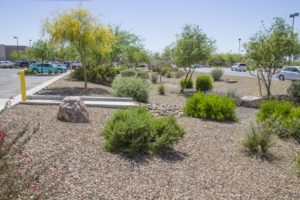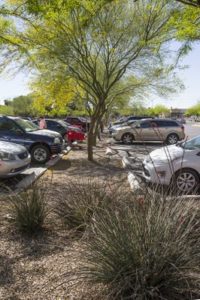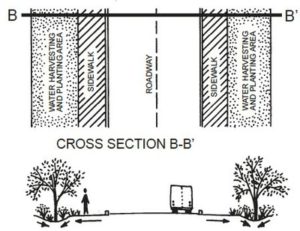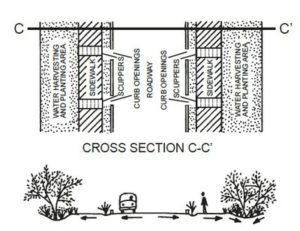In a region where fresh water is considered a precious resource, Tucson Arizona’s Water Harvesting Guidance Manual was developed to reduce dependence on existing sources while improving stormwater management. The Manual provides basic information and concepts for developers, engineers, designers and contractors of commercial sites, public buildings, subdivisions and public rights-of-way, to meet stormwater related Land Use Code requirements. The Manual is also useful for water harvesting for residential sites.
- Category
- Plumbing Systems Site and Stormwater
- Subcategory
- Rainwater Harvesting
- Adopted By
- City of Tucson, Arizona
- Applies To
- Landscape and stormwater management for commercial development and City-owned projects
- Owned By
- Department of Transportation, Stormwater Management
- Managed By
- Participation
- Year of Adoption
- 2005
- Current Version
- 2005
- Update Cycle
- Recent Action
- Code/Policy
- City of Tucson, Arizona
- Pursuant to
- City of Tucson Commercial Rainwater Harvesting
With dwindling groundwater reserves and Central Arizona Project (Colorado River) water, the Water Harvesting Manual is a crucial adaptive strategy to reduce potable water use while improving stormwater management. The Manual provides a process to evaluate site characteristics and develop integrated designs in which water harvesting enhances site efficiency, sustainability and aesthetics. It was developed in accordance with Mayor and Council direction, with oversight by the Stormwater Management Division of the City’s Transportation Department. In October 2005, the Mayor & Council passed an Ordinance supporting the Water Harvesting Guidance Manual for use by developers in planning a strategy to implement water harvesting for new developments, including City projects.
The Manual was created to give clarity to Land Use Code requirements for maximum use of site-generated stormwater. It became part of the guiding strategy for site, subdivision, and roadway design to reduce stormwater flows in streets and onto adjacent properties, and to reduce the use of potable water for landscaping. The Manual aided in the development of additional ordinances and policies including requiring water harvesting on commercial sites.
| Policy Title | Purpose of Policy |
|---|---|
| 2005 City of Tucson Water Harvesting Guidance Manual | The Water Harvesting Guidance Manual provides basic information and concepts to address site-generated stormwater management for commercial sites, public buildings, subdivisions, and rights-of-way to meet the City’s Land Use Code requirements. The goals of the Manual include reducing stormwater flows on streets and adjacent properties, keeping potential pollutants out of watercourses and groundwater, and reducing potable water use for landscaping. |
| 2008 City of Tucson Rainwater Harvesting Ordinance | Requires all commercial development and site plans after June 2010 to provide rainwater harvesting plans, and installation of a harvesting system, so that at least 50% of the site landscape irrigation water budget is supplied by the system, verified annually. |
To increase the implementation of water harvesting at large-scale sites, copies of the Manual were provided to city staff, engineers, landscape architects and other design professionals during meetings and presentations about water harvesting. The Manual was used as a guide in meetings between City staff and developers to discuss specific development sites and water harvesting strategies that would be appropriate. Copies were also provided to the public at water harvesting workshops and other outreach venues. As developers, engineers and landscape architects became more familiar with water harvesting strategies, They have been incorporated more frequently into site designs at larger scale sites. Water harvesting benefits the City and its residents by reducing the volume of stormwater flowing in streets or onto adjacent properties and by helping keep potential stormwater pollutants out of watercourses and groundwater. Water harvesting reduces the amount of potable water used for irrigation, saving development costs and reducing the demands placed on the region’s potable delivery system and declining water table.
Hundreds of sites now incorporate water harvesting in Tucson, Arizona. The 2009 map of notable sites prepared by Pima Association of Governments shows the location of physical sites, vendors, and locations of outreach and workshops. Author and regional expert Brad Lancaster provides detailed descriptions (and associated weblinks) of demonstration sites in Arizona on his website“Rainwater Harvesting for Drylands and Beyond” which is also the title of two books he wrote on the subject (Volumes I and II).
On October 18, 2005, the Mayor and Council passed an ordinance adopting the Water Harvesting Guidance Manual for use by developers, and by the City for their own projects, to implement water harvesting for new commercial developments. The Manual became part of the City’s strategy to address the Land Use Code requirements, listed below, providing specific guidance related to requirements for “maximum use” of site-generated stormwater. Appendix A: Tucson Code Requirements for Water Harvesting, of the manual provides interpretations and guidance about the Land Use Code provisions and intent with regard to harvesting stormwater:
The City of Tucson Code, Chapter 23, the ”Land Use Code” states:
- “Landscaping is intended to accomplish energy, water and other natural resource conservation, and, per sections 3.7.1.1.A.4 and .5, to “reduce soil erosion by slowing stormwater runoff” and “assisting in groundwater recharge.” (Section 3.7.1.1.A)
- “Grading, hydrology, and landscaping structural plans are to be integrated to make maximum use of site storm water runoff for supplemental onsite irrigation purposes.” (Section 3.7.4 Water Use)
- “Storm water and runoff harvesting to supplement drip irrigation are required elements of the irrigation system for both new plantings and preserved vegetation.” (Section 3.7.4.5.B, Irrigation)

The manual is primarily directed toward commercial developments, but the concept designs and configurations are easily adapted for residential lot use. While Land Use Code Section 3.7.4 says site plans will make maximum use of stormwater runoff for irrigation, the Manual provides interpretation that this means the maximum extent practicable. “Maximum extent practicable” will vary with each site. At a minimum, roof and Parking Area Access Lane stormwater shall be routed and impounded in the required landscaping areas to the extent that further stormwater harvesting would require site layout changes that would risk incompatibility with surrounding development. To achieve water harvesting to the maximum extent practicable, the developer will need to include water harvesting as an initial design criterion in an integrated design, not as a retrofit after layout is completed.

- Water harvesting will aid in meeting code requirements for Chapter 26, Floodplain and Erosion Hazard Management, Section 26-10, Detention/retention Systems. This code requires detention and threshold retention for developments in balanced and critical watersheds. Detention may be required for developments in non-designated watersheds depending on local hydrology. Detention requirements state that a development must match or decrease the site’s pre-development discharge rates for the 2-, 10- and 100-year flood events. Threshold retention requirements state that a development must retain onsite (no discharge) the stormwater volume difference between the pre- and post-development volumes for the 2- or 5-year flood events depending on the proposed use.
- The water harvesting retention volume designed to meet the maximum use requirement for water harvesting may be credited toward threshold retention volume requirements. Additionally, if water harvesting areas retain the entire stormwater volume for the 2-, 5-, 10- and/or 100-year flood events generated within the water harvesting areas themselves, the surface area of the water harvesting area may be deducted from the watershed area used to calculate required detention/retention quantities or volumes for those events.
- Applicability: CAUTION, water harvesting on single family residential lots shall not be credited against subdivision detention/retention requirements. Section 1.4 of the Stormwater Detention/Retention Manual indicates that individual lot detention/retention to meet code requirements is not allowed. Water harvesting is a technique that validates the noncontributing area factor allowed in the flood peak estimation method detailed in Chapter 4 of the City of Tucson Standards Manual for Drainage Design and Floodplain Management. To deduct water harvesting areas and/or volumes from site detention/retention requirements, the water harvesting volumes must be maintained to meet code conformance. They shall not be located in areas that will be removed by future development, such as future major streets and routes rights-of-way, without provisions for volume replacement
| Rainwater Harvesting for Drylands and Beyond by Brad Lancaster, Rainsource Press, June 2013: |
| Texas A&M AgriLife Extension, Rainwater Harvesting Resource Pageand Supply Tank Calculator |
| Watershed Management Group Resource Library |
| Desert Water Harvesting Initiative, University of Arizona Water Resources Research Center |
| General information and Rainwater Harvesting Manual, American Rainwater Catchment Systems Association (ARCSA), and ARCSA Foundation |
| Green Infrastructure, U.S. Environmental Protection Agency |


The City of Tucson Stormwater Ordinance responds to Federal regulations established under the Clean Water Act require large municipalities to implement measures to reduce pollutants in stormwater to the “maximum extent practicable.” As a result, Tucson was required to obtain a Municipal Stormwater Quality permit from the Environmental Protection Agency. To effectively implement the federal permit, Tucson must implement a Stormwater Ordinance that reflects federal requirements that developments include permanent structural controls to reduce pollutants discharged from a site. Onsite retention of the Stormwater Quality Storm (SQS) rainfall depth within the required landscape water harvesting areas will qualify as an excellent tool to control stormwater quality. Currently, the SQS rainfall depth for Tucson varies with impervious cover (imp) as follows: 0.30” for <25% imp, 0.40” for >25% to 70% imp, and 0.6” for >70% imp.
Practitioners
Water harvesting is a collaborative design element. It requires coordination of multiple disciplines when it is incorporated into designs for commercial sites, institutional sites and public rights of way. These could include developers, site designers, drainage engineers, transportation designers, landscape architects, building architects, grader operators, irrigation installers, landscape installers, tank installers, and others. At the household scale, water harvesting can often be designed and constructed by homeowners. Additional practitioners could include tank installers, landscape architects, grader operators, irrigation installers, landscape installers and others.
Water harvesting can save money on potable water use, stormwater management and clean up of pollutants. Creating the footprint of passive water harvesting establishes long-term drainage patterns that secure on-going water harvesting without further large structural adjustments. On-going maintenance is needed for landscapes management and erosion control.
Water harvesting is a logical and efficient strategy to increase water sources to support landscapes and to assist in stormwater management. Passive water harvesting (infiltration into earthen depressions) can be incorporated into new and substantially redeveloped commercial and institutional sites fairly easily once drainage engineers are comfortable with the concept of utilizing stormwater in multiple locations within a site. However, it can be more challenging to incorporate passive water harvesting into sites with standard grading since this is typically designed to route runoff water to detention basins or off the site. Passive water harvesting is less expensive than incorporating large-scale rainwater tanks into site designs. Once in place, passive water harvesting benefits continue over long periods of time, without substantially more maintenance than conventional grading designs and landscapes. Additionally, passive strategies can have greater water harvesting capacity than tanks, where the water can be guided to site landscaping and infiltrated for both irrigation and recharge.
Tucson’s Manual has been used by other jurisdictions as a model for developing guidance in their locations. Following development of the City of Tucson Water Harvesting Guidance Manual, the City went on to implement both additional regulations and incentives for water harvesting:
The City of Tucson adopted the Commercial Rainwater Harvesting – Ordinance 10597 on October 14, 2008.
The City of Tucson water harvesting rebate program was developed to promote water harvesting at residential sites. The program provides a rebate of up to $2000 for qualifying water harvesting systems.
